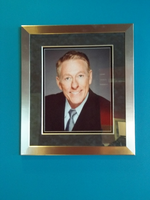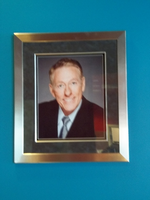Search the Special Collections and Archives Portal
Search Results
Audio clip from interview with Dorothy Eisenberg, October 23, 2014
Date
Archival Collection
Description
Part of an interview with Dorothy Eisenberg on October 23, 2014. In this clip, Eisenberg discusses how she became involved with the Democratic party and the League of Women Voters in Las Vegas.
Sound
Cherina Kleven Papers
Identifier
Abstract
The Cherina Kleven Papers (approximately 1988-2014) document the career of Cherina Kleven who was the first Asian-American appointed as Assistant Fire Chief for Las Vegas Fire & Rescue. The materials primarily include physical and digitized photographs of Kleven in her capacity as Assistant Fire Chief, magazine and newspaper articles featuring Kleven, and event programs. Also included are campaign fliers from 2010 when Kleven ran for office to represent Assembly District 15 in the Nevada Legislature as well as two commemorative books celebrating the history of Las Vegas Fire & Rescue.
Archival Collection
Henry C. Wieking Photograph Collection
Identifier
Abstract
The Henry C. Wieking Photograph Collection contains black-and-white photographic prints and negatives, as well as postcards of Las Vegas, Nevada between approximately 1920 and 1940. These images primarily depict Wieking and his family in front of the Las Vegas Mormon Fort and Hoover Dam (Boulder Dam). Other photographs include Six Companies and United States Bureau of Reclamation vehicles, Mount Charleston, the Colorado River, Black Canyon, and desert scenes. The remaining images depict Barstow and Death Valley, California; and a Grand Canyon bridge in Arizona.
Archival Collection
Apolonio Sauceda Scrapbooks
Identifier
Abstract
The Apolonio Sauceda Scrapbooks (1973-2010) document Apolonio "Loney" Sauceda's acting career and his work with the Nevada Association for Latin Americans (NALA) in Las Vegas, Nevada. Two scrapbooks document Sauceda's career as an actor and contain photographs of Sauceda on set, at premieres, with other actors, and depict movie sets at well-known Las Vegas hotels and casinos in the 1980s and 1990s. Newspaper clippings accompany many of the photographs and provide details about locations, major actors, or the producers for each film. The third scrapbook is compiled of newspaper clippings that document the local Las Vegas, Nevada Latinx community and NALA events in the 1970s, ranging from political activism, labor strikes, beauty pageants, and religious gatherings.
Archival Collection
Arturo Amaya Papers
Identifier
Abstract
The Arturo Amaya Papers (1994-2017) are comprised of photographs and periodicals representing Amaya's involvement with the Latinx community in Las Vegas, Nevada. In particular, the photographs document activities of the Las Vegas Peruvian Cultural Heritage Association that Amaya founded. The collection includes issues of local magazines Amaya was involved with as a creator, publisher, and writer including:
Archival Collection
James Bilbray Papers
Identifier
Abstract
The James Bilbray Papers contain materials dating from 1979 to 2003, with the bulk of material dating from 1983 to 1985 during Bilbray’s service in the Nevada State Senate. It includes correspondence from constituents, correspondence from Bilbray, legislative materials, and fiscal reports presented to the Senate Finance Committee. The collection also contains a small number of reports from the Congressional Research Service.
Archival Collection

Robert L. "Bob" Forbuss portrait, interior at the Gay and Lesbian Community Center, three days before grand opening: digital image
Date
Archival Collection
Description
Image

Robert L. "Bob" Forbuss portrait, interior at the Gay and Lesbian Community Center, three days before grand opening: digital image
Date
Archival Collection
Description
Image

Transcript of interview with George Levine by Barbara Tabach, April 16, 2015
Date
Archival Collection
Description
In this interview, George reflects upon his life in Las Vegas, particularly the period as ma?tre d? of the Sand?s Copa Room. Joined by his daughter - and former United States Democratic Congresswomen-Shelley Berkley, George shares stories of working in the gaming industry during this unique era, including those of Frank Sinatra and Wayne Newton. He also talks about his life as a professional gambler.
Born on February 28, 1925 in Sommerville, New Jersey, George Levine?s family moved to his childhood home, Manhattan?s Lower East Side, when he was six months old. George served on a United States Navy aircraft carrier for thirty months during World War II. After returning home, he met his first wife Estelle, with whom he had two daughters, and soon moved to Kiamesha Lake, New York to work at the Concord Resort Hotel. In 1963, George and his family moved to Las Vegas and took his first job at Mr. Sy?s Casino. Six months later he began waiting tables at the Sands Hotel and Casino. He worked his way up the ranks and was ma?tre d' from 1979 until the hotel closed in 1996.
Text

Transcript of interview with Mindy Unger-Wadkins by Barbara Tabach, October 28, 2015
Date
Archival Collection
Description
In this interview, Unger-Wadkins discusses growing up in Las Vegas? close-knit Jewish community in the 1960s and 1970s, and involvement with various Jewish youth organizations and activities. She also describes her career in public relations, reflecting upon the unique challenges faced when interacting with the public, and with politics, in her positions. Unger-Wadkins ends by describing her current work in land development, particularly the history of the Three Kids Mine and the technical and political process of ensuring the land is suitable as a residential area.
Text
